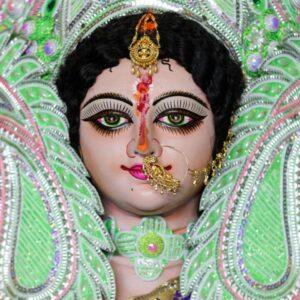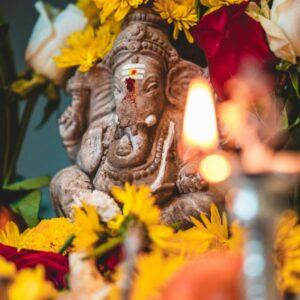Introduction
Hindu mythology is rich with tales of gods and divine beings, but among them, Lord Vishnu stands out as the preserver and protector. This article delves into the fascinating concept of “Dashavatars,” or the ten incarnations of Lord Vishnu, exploring their stories, symbolism, and significance. Whether you’re a devout follower or simply curious, this journey through ancient legends promises to be enlightening.
Who is Lord Vishnu?
Lord Vishnu is one of the principal deities in Hinduism, revered as the preserver and protector within the Holy Trinity (Trimurti), which also includes Brahma the creator and Shiva the destroyer. Depicted with a serene demeanor, often with blue skin and four arms, Vishnu holds a conch, a discus, a mace, and a lotus flower. His role is to maintain cosmic order and protect dharma (righteousness) whenever it is threatened.
Vishnu’s many avatars (incarnations) serve to restore balance in the world. He descends to Earth in various forms during times of chaos to save humanity from evil forces. These avatars are collectively known as the Dashavatars.
Significance of Lord Vishnu
Lord Vishnu’s significance extends beyond his role as a preserver. He embodies qualities like compassion, mercy, and wisdom. His stories are not just mythological tales but moral lessons that guide followers on how to lead a righteous life. Vishnu’s consort, Goddess Lakshmi, symbolizes wealth and prosperity, further enhancing his role as a sustainer.
In various scriptures like the Vedas, Puranas, and epics such as Mahabharata and Ramayana, Vishnu’s exploits are recounted with reverence. His teachings emphasize the importance of living a virtuous life and adhering to one’s duties.
The Concept of Dashavatars
The term “Dashavatar” translates to “ten avatars.” According to Hindu belief, Vishnu incarnates in different forms to combat evil and restore cosmic order. These avatars range from aquatic creatures to human forms and even a future prophecy yet to materialize.
Each avatar has its unique story and significance, often reflecting the evolutionary progress from aquatic life to human civilization. These ten avatars are Matsya (fish), Kurma (turtle), Varaha (boar), Narasimha (half-man, half-lion), Vamana (dwarf), Parashurama (warrior with an axe), Rama (prince), Krishna (cowherd and prince), Buddha (enlightened being), and Kalki (future warrior).
Matsya Avatar
The Story of Matsya
The Matsya avatar marks Vishnu’s first incarnation as a giant fish. According to legend, King Manu was performing his daily ablutions when he found a small fish in his hands. The fish requested protection, promising to save Manu from an impending flood. As Manu nurtured the fish, it grew larger and larger until he released it into the ocean.
When the flood came, Matsya guided Manu’s boat, which carried seeds of all plants and one pair of every animal species, ensuring the survival of life on Earth.
Symbolism of Matsya
Matsya represents the beginning of life forms in water and signifies salvation during times of crisis. It underscores Vishnu’s role as a savior who ensures continuity even during catastrophic events.
Matsya in Scriptures
The story of Matsya is primarily found in the Satapatha Brahmana and Puranas like Bhagavata Purana. It draws parallels with flood myths found in other cultures, such as Noah’s Ark in Abrahamic traditions.
Kurma Avatar
The Story of Kurma
Kurma, the turtle incarnation, plays a pivotal role in the churning of the ocean (Samudra Manthan). When gods (Devas) and demons (Asuras) sought the nectar of immortality (Amrita), they used Mount Mandara as a churning rod. However, the mountain began sinking into the ocean.
Vishnu incarnated as Kurma to support the mountain on his back, allowing the churning to continue until Amrita was obtained.
Symbolism of Kurma
Kurma signifies stability amidst turmoil and chaos. It highlights Vishnu’s ability to provide support during challenging times.
Kurma in Scriptures
The story of Kurma appears in various texts like Mahabharata and Bhagavata Purana. It illustrates cooperation between opposing forces for a common goal.
Varaha Avatar
The Story of Varaha
Varaha is Vishnu’s boar incarnation. In this avatar, he rescued Earth (personified as Goddess Bhudevi) from the demon Hiranyaksha, who had submerged it into the cosmic ocean. Varaha dived into the ocean, fought Hiranyaksha for a thousand years, and finally lifted Earth on his tusks.
Symbolism of Varaha
Varaha represents strength and courage to overcome darkness and ignorance. It emphasizes Vishnu’s role as a protector of Earth and its inhabitants.
Varaha in Scriptures
The tale of Varaha is detailed in texts like Vishnu Purana and Devi Bhagavata Purana. It highlights themes of resilience and divine intervention against evil.
Narasimha Avatar
The Story of Narasimha
Narasimha is a unique avatar with the body of a man and the head and claws of a lion. This form was taken to slay the demon king Hiranyakashipu, who was granted a boon that made him nearly invincible. He couldn’t be killed by man or beast, inside or outside, day or night.
Narasimha emerged at twilight (neither day nor night), on a threshold (neither inside nor outside), and killed Hiranyakashipu with his claws (neither man nor beast).
Symbolism of Narasimha
Narasimha symbolizes fierce protection against evil. It demonstrates that divine intervention can overcome seemingly impossible obstacles.
Narasimha in Scriptures
Narasimha’s story is narrated in texts like Bhagavata Purana and Narasimha Purana. It serves as a reminder that righteousness will ultimately prevail over tyranny.
Vamana Avatar
The Story of Vamana
Vamana is Vishnu’s dwarf avatar. He appeared during the reign of Bali, a demon king who had gained control over Heaven and Earth through penance and strength. Disguised as a dwarf Brahmin, Vamana approached Bali during a yajna (sacrifice) and requested three paces of land.
When Bali agreed, Vamana transformed into a giant form (Trivikrama) and covered Heaven and Earth with two steps. For the third step, Bali offered his head, acknowledging Vamana’s divinity.
Symbolism of Vamana
Vamana represents humility and divine authority. It highlights that true power lies not in physical strength but in righteousness.
Vamana in Scriptures
The story of Vamana is found in texts like Bhagavata Purana and Rigveda. It underscores themes of devotion and surrender to divine will.
Parashurama Avatar
The Story of Parashurama
Parashurama is Vishnu’s warrior avatar wielding an axe (parashu). Born to sage Jamadagni and Renuka, he embarked on a mission to rid the world of corrupt Kshatriya rulers who had deviated from dharma.
Parashurama’s tales involve numerous battles where he defeated oppressive kings and restored dharma. Despite his warrior nature, he eventually retired to a life of penance.
Symbolism of Parashurama
Parashurama embodies justice through force when necessary. His story underscores that sometimes righteousness requires decisive action against wrongdoing.
Parashurama in Scriptures
Parashurama’s exploits are detailed in texts like Mahabharata and various Puranas. He is also considered one of the seven immortal beings (Chiranjivi) who exist through ages.
Rama Avatar
The Story of Rama
Rama is one of Vishnu’s most beloved avatars, depicted as an ideal king in the epic Ramayana. Born as Prince Rama in Ayodhya, he embarked on an epic journey to rescue his wife Sita from the demon king Ravana with the help of Hanuman and an army of monkeys.
Rama’s life exemplifies virtues like honor, duty (dharma), courage, and compassion. His reign is often referred to as “Rama Rajya,” symbolizing a period of peace and prosperity.
Symbolism of Rama
Rama epitomizes the perfect human being—an embodiment of virtue and righteousness. His story teaches adherence to duty even under challenging circumstances.
Rama in Scriptures
The Ramayana by Valmiki remains one of Hinduism’s most revered texts. Stories about Rama also appear in various Puranas and regional adaptations across India.
Krishna Avatar
The Story of Krishna
Krishna is perhaps one of Vishnu’s most complex avatars with multifaceted roles—as a mischievous child stealing butter, a divine lover playing flute for Radha and Gopis (milkmaids), and a wise charioteer imparting Bhagavad Gita’s teachings to Arjuna on Kurukshetra battlefield.
Krishna’s narratives span from childhood pranks to diplomatic strategies during Mahabharata war where he played pivotal roles influencing its outcome while upholding dharma.
Symbolism of Krishna
Krishna symbolizes divine love & wisdom intertwined with playful spontaneity & strategic acumen illustrating versatility inherent within divinity capable navigating diverse life scenarios effectively embodying holistic approach towards righteous living encompassing all aspects existence harmoniously balanced manner!
Krishna In Scriptures:
Krishna extensively chronicled major Hindu texts including Mahabharata Bhagavad Gita Srimad Bhagavatam His influence profound permeating deeply into cultural fabric subcontinent resonating timelessly through centuries remaining ever relevant contemporary context amidst evolving societal dynamics!
Buddha Avatar
The Story Of Buddha:
Buddha depicted ninth avatar represents significant departure traditional avatars embodying quest enlightenment detachment material world attainment spiritual liberation Siddhartha Gautama born princely family renounced worldly pleasures embarked transformative journey self-discovery ultimately attaining nirvana founding Buddhism profoundly impacting spiritual philosophical landscape Asia beyond!
Symbolism Of Buddha:
Buddha epitomizes quest inner peace realization transcending material attachments emphasizing importance meditation mindfulness ethical conduct fostering compassionate harmonious coexistence among beings!
Buddha In Scriptures:
Buddha extensively chronicled Buddhist texts like Tripitaka various Puranic accounts highlighting evolution avatar concept reflecting dynamic interplay between evolving spiritual paradigms within broader Hindu cosmology!
Kalki Avatar:
The Prophecy Of Kalki:
Kalki prophesied future avatar destined appear end Kali Yuga current epoch characterized moral decline societal chaos armed mighty sword riding white horse restore dharma annihilate evil ushering new age righteousness Satya Yuga ensuring cyclical renewal cosmic order perpetuated!
Symbolism Of Kalki:
Kalki symbolizes ultimate redemption transformative force heralding dawn new era emphasizing cyclical nature time inherent capacity renewal through divine intervention!
Kalki In Scriptures:
Kalki extensively chronicled Puranas particularly Vishnu Purana Bhagavata Purana detailing prophecies surrounding advent culmination cosmic cycles!
Common Themes In Dashavatars:
Dashavatars collectively embody progressive evolution life forms culminating human civilization encapsulating diverse aspects existence ranging survival adaptability strength wisdom compassion enlightenment justice redemption illustrating holistic approach towards understanding divinity cosmic order interwoven seamlessly narratives timeless relevance!
Dashavatars And Their Relevance Today:
Dashavatars timeless relevance transcends mythological narratives serving moral ethical guideposts navigating complexities contemporary existence addressing challenges through principles embodied avatars emphasizing importance righteousness adaptability compassion wisdom collective well-being fostering harmonious sustainable societies amidst evolving global dynamics!
Lord Vishnu In Modern Culture:
Lord Vishnu continues resonate deeply within modern culture influencing arts literature cinema popular culture inspiring diverse creative expressions ranging classical dance forms contemporary interpretations symbolizing enduring legacy timeless relevance amidst changing societal paradigms reflecting rich cultural heritage vibrantly alive evolving context!
Conclusion:
The tales surrounding Lord Vishnu Dashavatars remain profound reservoirs wisdom moral guidance timeless relevance navigating complexities existence fostering deeper understanding divinity interconnectedness cosmic order emphasizing importance righteousness compassion collective well-being inspiring generations towards harmonious sustainable living amidst evolving global dynamics reflecting enduring legacy rich cultural heritage vibrantly alive ever-evolving context!
FAQs:
What does Dashavatar mean?
Dashavatar translates to “ten avatars” referring ten incarnations Lord Vishnu descending earthly realm restore cosmic order combatting evil forces preserving righteousness!
Why did Vishnu take different avatars?
Vishnu incarnates different forms restore balance protect dharma during times crisis ensuring continuity preservation cosmic order guiding humanity towards righteous path!
Who is considered tenth avatar?
Kalki prophesied future tenth avatar destined appear end Kali Yuga armed mighty sword riding white horse restore dharma annihilate evil usher new era righteousness Satya Yuga!
What significance Buddha avatar?
Buddha ninth avatar represents quest inner peace enlightenment transcending material attachments emphasizing meditation mindfulness ethical conduct fostering compassionate harmonious coexistence among beings!
How relevant Dashavatars today?
Dashavatars timeless relevance transcends mythological narratives serving moral ethical guideposts addressing contemporary challenges through principles embodied avatars emphasizing importance righteousness adaptability compassion wisdom collective well-being fostering harmonious sustainable societies!
Where can I learn more about Lord Vishnu Dashavatars?
To explore further refer sacred texts like Bhagavad Gita Ramayana Mahabharata Puranas extensive literature available both traditional contemporary interpretations reflecting rich cultural heritage vibrantly alive ever-evolving context!


